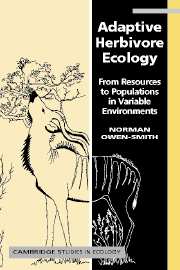Book contents
- Frontmatter
- Contents
- Acknowledgements
- Acronym and symbol conventions
- 1 Conceptual origins : variability in time and space
- 2 Consumer–resource models : theory and formulation
- 3 Resource abundance : intake response and time frames
- 4 Resource distribution : patch scales and depletion
- 5 Resource quality : nutritional gain and diet choice
- 6 Resource constraints : physiological capacities and costs
- 7 Resource allocation : growth, storage and reproduction
- 8 Resource production : regeneration and attrition
- 9 Resource competition : exploitation and density dependence
- 10 Resource-dependent mortality : nutrition, predation and demography
- 11 Habitat suitability : resource components and stocking densities
- 12 Resource partitioning : competition and coexistence
- 13 Population dynamics : resource basis for instability
- 14 An adaptive resource ecology : foundation and prospects
- References
- Index
7 - Resource allocation : growth, storage and reproduction
Published online by Cambridge University Press: 04 February 2011
- Frontmatter
- Contents
- Acknowledgements
- Acronym and symbol conventions
- 1 Conceptual origins : variability in time and space
- 2 Consumer–resource models : theory and formulation
- 3 Resource abundance : intake response and time frames
- 4 Resource distribution : patch scales and depletion
- 5 Resource quality : nutritional gain and diet choice
- 6 Resource constraints : physiological capacities and costs
- 7 Resource allocation : growth, storage and reproduction
- 8 Resource production : regeneration and attrition
- 9 Resource competition : exploitation and density dependence
- 10 Resource-dependent mortality : nutrition, predation and demography
- 11 Habitat suitability : resource components and stocking densities
- 12 Resource partitioning : competition and coexistence
- 13 Population dynamics : resource basis for instability
- 14 An adaptive resource ecology : foundation and prospects
- References
- Index
Summary
Surplus resources gained from the environment while foraging, in excess of basic maintenance needs, can be allocated to biomass increase in different ways. Consumers can (a) grow in individual body size, (b) add to stored body reserves, or (c) divert resources to nurture the growth of offspring. The relative advantages of these alternative investments depend on the age, size and current body condition of individual animals, and also on timing within the seasonal cycle of resource abundance. The patterns of allocation by different individuals govern how food gains become transformed into population biomass dynamics. At times resource gains may be insufficient to cover physiological losses, so that population biomass declines.
In a variable environment, tradeoffs need to be made between surplus gains at one time and deficits incurred at a later stage. Evaluating the outcome requires a dynamic approach to optimization. In particular, we must consider the consequences of allocation decisions for the future body state of individual animals over some extended period. The time frame thus expands to an annual cycle or longer, ultimately up to individual lifespans.
In this chapter, we consider first how resource gains become transformed into a biomass growth potential, taking into account losses to maintenance metabolism. The simplest decision is then considered, whether and when to allocate surplus resources to fat stores, for fully grown animals that have no growth potential. The benefits of having body reserves need to be balanced against the costs of acquiring and carrying them.
- Type
- Chapter
- Information
- Adaptive Herbivore EcologyFrom Resources to Populations in Variable Environments, pp. 136 - 161Publisher: Cambridge University PressPrint publication year: 2002



